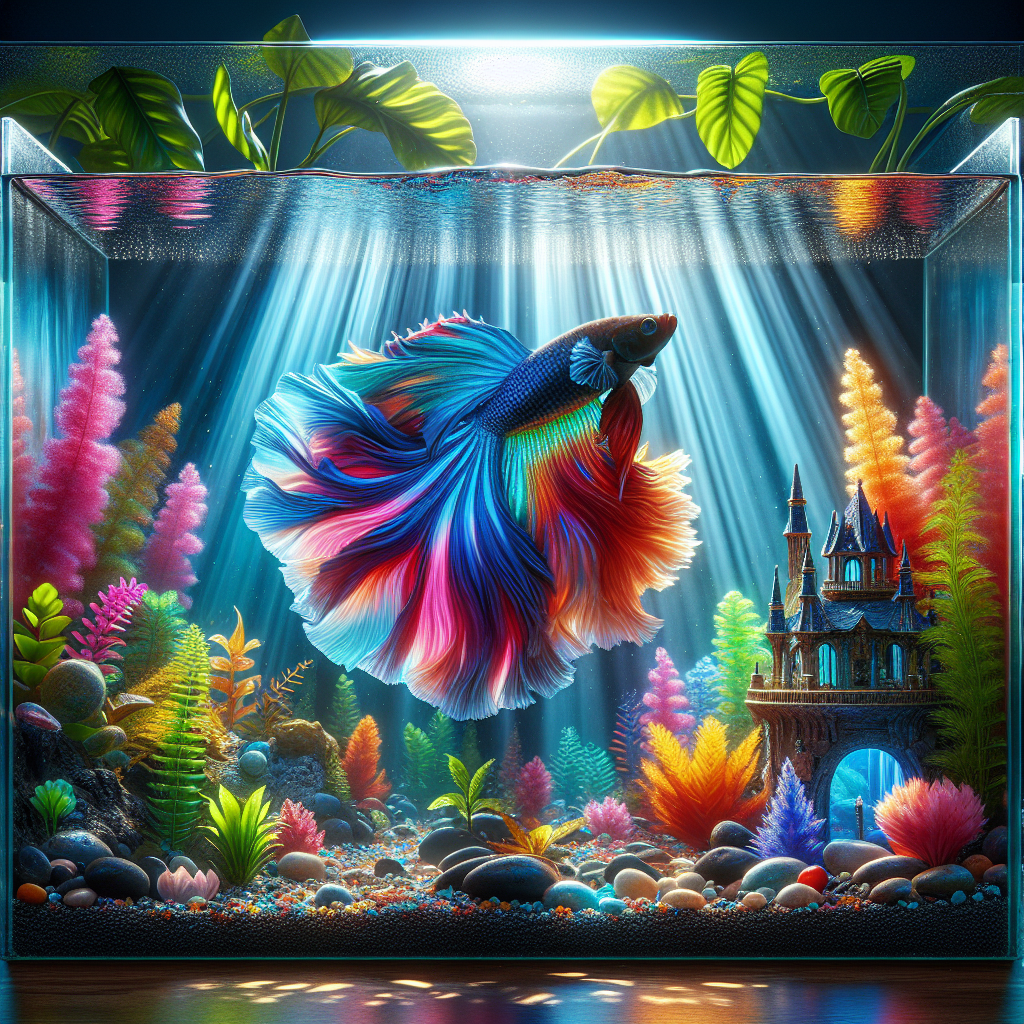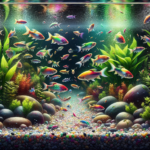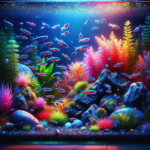
-
Custom betta tanks provide a habitat tailored to your fish’s needs and your personal style.
-
Minimum recommended tank size for bettas is at least 5 gallons to ensure a healthy environment.
-
When choosing tank materials, consider the durability and clarity of glass versus acrylic.
-
Essential features for betta tanks include a gentle filter, a heater to maintain stable temperatures, and appropriate lighting.
-
Setting up a custom betta aquarium can range from affordable DIY options to more premium setups.
Choosing the Right Size – Room for Fins to Flourish
Size matters, especially when it comes to betta tanks. While bettas can survive in smaller spaces, they truly thrive when given room to swim freely. A larger tank not only benefits your betta’s health but also allows for more design options.
Minimum Tank Requirements
A good rule of thumb is to start with at least a 5-gallon tank. This size gives your betta ample space to swim and is large enough to support a stable environment, which is critical for maintaining water quality and temperature.
Does Bigger Mean Better? In the case of betta tanks, often, yes. Larger tanks offer more stable environments and give you more room for plants, decorations, and even tank mates if you choose carefully. But remember, more water means more maintenance, so find a balance that works for you and your lifestyle.
Materials Matter – Glass vs. Acrylic Aquariums
When it comes to tank materials, you have two main choices: glass and acrylic. Each has its benefits and drawbacks, and understanding these will help you make the best decision for your betta’s home.
Comparing Durability and Clarity
Glass is the traditional choice for aquariums, and for good reason. It’s highly scratch-resistant and maintains clarity over time. Acrylic, on the other hand, is lighter and can be molded into various shapes, offering more customization options. However, it scratches more easily and can become discolored.
Weight and Placement Considerations
Think about where your tank will live. Acrylic tanks are much lighter than glass, making them easier to move and less likely to need a heavy-duty stand. But if you’re setting up a larger tank and don’t plan to move it often, the enduring clarity of glass might be the way to go.
Key Features of a Betta-friendly Tank
To keep your betta healthy and happy, there are a few key features every tank should have. It’s not just about looking good; it’s about creating the best possible environment for your fish.
Equipping with the Perfect Filter
Bettas don’t like strong currents, so a filter with an adjustable flow is ideal. You want to keep the water clean without stressing your fish. Look for filters that are specifically designed for smaller tanks to ensure a gentle flow that won’t overwhelm your betta.
The Importance of Steady Temperatures
Bettas are tropical fish and require a consistent temperature between 76 and 80 degrees Fahrenheit. A reliable heater is a must to keep your tank within this range. Choose one with an adjustable thermostat and make sure it’s appropriately sized for your tank’s volume.
Lighting Up Your Betta’s World: Bettas don’t need intense light, but they do appreciate a day-night cycle just like us. A simple LED light fixture can mimic natural light patterns and even highlight your betta’s colors. Plus, if you’re growing live plants, they’ll need light to thrive, too.
Designing with Aesthetics in Mind
Designing your betta tank is where you can let your creativity shine. The visual appeal of your aquarium is just as important as its functionality. After all, this is a piece of living art that you’ll be looking at every day, and you want it to be something that makes you smile.
Making a Statement with Your Aquarium
Your aquarium can be more than just a home for your betta; it can be an expression of your personality. Whether you’re drawn to sleek, modern designs or lush, naturalistic settings, the style of your tank should resonate with you. Consider the colors of your betta when choosing decorations to complement or contrast beautifully with their hues.
Besides that, the layout of your tank can tell a story. You might want to recreate a scene from a favorite movie or a memory from a trip. With custom tanks, the possibilities are endless, and the result is a tank that’s uniquely yours.
Harmony between Home Decor and Habitat
When setting up your custom betta tank, think about how it will fit into the space it’s in. You want your tank to complement your home’s decor, not clash with it. The tank’s placement should also allow for easy viewing and maintenance. Consider the lighting in the room, too, as this will affect how you see your betta and their environment.
Cost Breakdown – Investing in Your Betta’s Happiness
Creating the ideal home for your betta is an investment. Let’s break down the costs you can expect for setting up a custom betta fish tank, keeping in mind that prices can vary based on quality, size, and design.
The Initial Setup: What to Expect
For a basic 5-gallon tank setup, costs can range from $30 to $100. This would typically include the tank itself, a filter, and a heater. If you opt for an acrylic tank, the price might be on the lower end, but if you prefer glass, expect to pay a bit more. Remember, this is just the beginning. Decorations, substrate, and plants will add to the total cost.
Long-term Savings: Quality vs. Price
While you might be tempted to go for the cheapest options, investing in quality can save you money in the long run. A reliable filter and heater will last longer and perform better, meaning less stress for you and your betta. Quality substrates and decorations will not only look better, but they’ll also be safer for your fish.
Streamlined Betta Abodes – Popular Custom Aquariums Reviewed
There are plenty of options out there for custom betta tanks, ranging from kits that include everything you need, to high-end, designer models. Let’s take a look at a few popular choices that cater to different budgets and tastes.
Economical Options for Starters
If you’re new to betta care, starting with an all-in-one aquarium kit can be a great option. These kits often include a tank, filter, and sometimes a light and heater, all for an affordable price. An example of this is the Marina LED Aquarium Kit, which comes in a 5-gallon size perfect for bettas and costs around $50-$70.
Premium Alternatives for Enthusiasts
For the more experienced enthusiast willing to invest more, there are tanks like the Fluval Spec V Aquarium Kit. This 5-gallon tank features a sleek design and comes with a powerful filtration system and LED lighting, usually priced between $100-$150. It’s a beautiful and functional choice for those looking to splurge a little on their betta’s environment.
DIY Stylings – Building Your Own Betta Ecosystem
For those who prefer a hands-on approach, building your own betta tank can be a rewarding project. You’ll need to gather your supplies, which include the tank, filter, heater, lighting, substrate, and decorations.
Gathering Your Supplies
Start by choosing a tank. A standard 5-gallon glass tank can cost about $10-$15. Next, pick a filter; sponge filters are gentle and effective, costing around $5-$10. A small, adjustable heater will be in the range of $10-$20, and LED lighting can vary, but expect to spend $10-$30. Substrate and decorations will depend on your design, but you can set aside $20-$50 for these.
Step-by-Step Assembly Guide
Once you have all your supplies, it’s time to assemble your tank. Begin by rinsing your substrate and decorations. Place the substrate in the tank, then arrange your decorations. Fill the tank with water, treat it with a water conditioner, and set up your filter and heater. Finally, add your lighting, and let the tank cycle before introducing your betta.
Why Customize? The Perks of Tailored Betta Spaces
Every betta is unique, and so should be their home. Customizing your betta’s aquarium means you’re not just buying a tank, but creating a habitat that reflects both your fish’s needs and your personal taste. It’s a chance to be creative and ensure that your pet lives in comfort and style.
Addressing Betta’s Unique Lifestyle
Bettas are known for their need for space to swim and plants to hide in. A custom tank allows you to design an environment that mimics their natural habitat, which is crucial for their wellbeing. This means plenty of room to explore and appropriate hiding spots that offer security.
Personal Touch to Betta Living
When you customize, you’re putting a piece of yourself into the design. Maybe it’s a color scheme that matches your room or a theme that tells a story. This personal touch will make the tank a conversation piece and something you can be proud of every time you see your betta enjoying its home.
Your Betta’s New Home – Final Reflections
After setting up your custom betta fish aquarium, take a step back and admire your work. You’ve not only created a functional habitat for your pet but also a personalized piece of living decor that reflects your dedication. Most importantly, you’ve provided a space where your betta can thrive and exhibit its natural behavior, which is the ultimate reward for any fish enthusiast.
-
Monitor water quality regularly to ensure a healthy environment for your betta.
-
Perform partial water changes weekly to keep the tank clean and balanced.
-
Feed your betta a varied diet and avoid overfeeding to maintain water quality.
-
Observe your betta’s behavior to ensure they are active, healthy, and happy in their new home.
-
Enjoy the process of caring for your betta and the serene beauty they bring to your life.
Remember, the journey doesn’t end with the setup. Caring for your betta is an ongoing process that requires attention and love. But the joy of seeing your betta swim through a tank you’ve designed just for them is a truly unique experience. So, take pride in your creation and the new life you’ve enriched.
Frequently Asked Questions (FAQ)
As you embark on your journey of setting up a custom betta fish aquarium, you may have some questions. Here are answers to some of the most common queries to help you get started on the right fin.
How Much Should I Budget for a Custom Betta Tank?
A custom betta tank setup can vary in cost depending on the size, materials, and features you choose. For a basic 5-gallon setup, you can expect to spend between $50 and $100. If you’re looking for more advanced options or larger sizes, the price can go up to $200 or more. Remember, investing in quality equipment upfront can save you money and trouble in the long run.
What Size Aquarium is Best for a Single Betta?
The minimum recommended size for a betta fish aquarium is 5 gallons. This provides enough space for your betta to swim and for the water parameters to remain stable. Larger tanks can offer more design options and can be easier to maintain, but they also take up more space and can be more expensive.
Here’s a quick size guide:
-
5 gallons: Minimum size for one betta.
-
10 gallons: Ideal for a single betta with more room for decorations and plants.
-
20+ gallons: Suitable for a community tank with carefully selected tank mates.
Is Tap Water Safe for Betta Fish?
Tap water can be safe for betta fish, but it must be treated with a water conditioner to remove chlorine, chloramines, and heavy metals. Always check the water parameters such as pH, hardness, and temperature to ensure they fall within the suitable range for bettas.
Can I Keep Other Fish with My Betta?
Bettas are known for their territorial nature, so care must be taken when selecting tank mates. Non-aggressive, similarly sized fish that do not have long fins are usually suitable. Some good options include small rasboras, corydoras, and snails. Always introduce new tank mates gradually and monitor their interactions.
What is the Ideal Temperature for a Betta Tank?
The ideal temperature for a betta tank is between 76 and 80 degrees Fahrenheit. Bettas are tropical fish and require a warm, stable environment. A reliable aquarium heater with an adjustable thermostat is essential to maintain the correct temperature.




